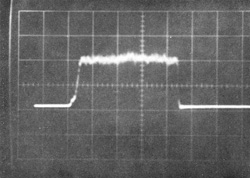Historical Moment at NAL - 1st NAL Proton Beam

A photo of the early accelerated proton beam from NAL's pre-accelerator: 200 milliamperes during 80 microseconds pulse
It was at 1:45 p.m. on April 17, 1969 that members of the NAL Linac Section obtained a beam of protons from the preaccelerator, the first and smallest of four cascaded accelerators which will comprise the complete 200 BeV accelerator.
The preaccelerator includes an ion source to produce the protons, and an accelerating column to give the protons a speed of four percent of the speed of light and a kinetic energy of 750,000 electron volts. The interior of the column under vacuum, one foot in length, withstands a voltage of 750,000 volts across it and operates in principle like the accelerating portion of an electron gun in a television picture tube.
Design, fabrication and testing of the preaccelerator to the present time has been primarily the responsibility of Cyril Curtis, physicist; Glenn Lee, mechanical engineer; and Charles Sharp, Gregory Urban, Raymond Hren and James Wendt, technicians. Many other persons in the Linac Section and elsewhere have made important contributions in bringing the system to its present stage of completion. A part of the construction was accomplished in the Physical Science Laboratory of the University of Wisconsin. The assistance of Argonne National Laboratory in the loan of their high voltage supply, while the NAL supply is under construction, made the early testing of the preaccelerator possible.
Protons are produced in the ion source by striking an arc discharge in hydrogen gas. The single negative electron is thereby stripped from the hydrogen atom leaving the positive nucleus, a proton, to float freely in the resulting plasma Application of an electric force field extracts protons from the surface of the plasma and sends them' on their way as a stream of positive particles.
Operation of the ion source first occurred January 20. Bean currents up to 300 milliamperes were obtained. To elate a current of approximately 50 milliamperes has been accelerated through the column to 745,000 electron volts of energy during initial testing The goal is a beam current of 225 milliamperes with highly directive properties for injection into the Linear Accelerator (Linac).
The properties of the beam from the preaccelerator are important in influencing the "quality" of the beam at all later staves of acceleration in the Linac, Booster, and Main Ring. At the highest energy there is a memory of the beam properties from the preaccelerator, with little that can be done to improve, albeit much that can be done to degrade, the initial beam quality. Effort therefore, will be devoted during the coming months to beam measurements and ion source adjustments for achieving the best beam quality.


